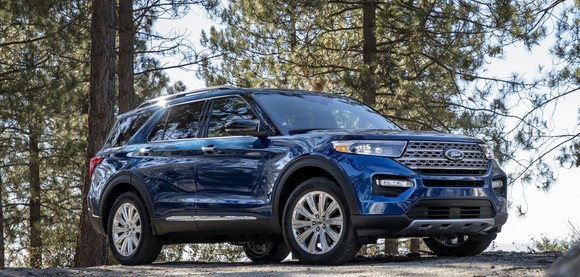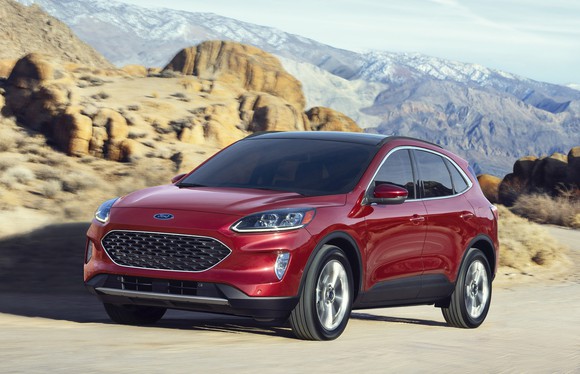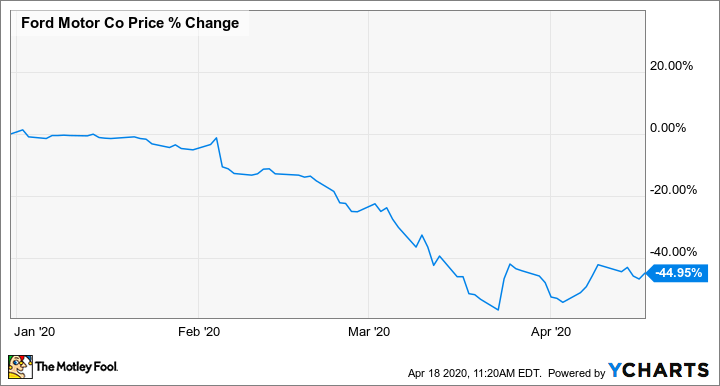2020 was supposed to be a good year for Ford Motor (F +1.85%). As the year began, with sales of the all-new Explorer and Escape gathering steam, Ford was looking ahead to an all-new Bronco in the spring -- and an all-new F-150 by year-end. After a couple of years of slumping margins, the future was looking bright.
But as we all know, nature -- specifically, a certain virus -- had other plans.
The effects of the coronavirus pandemic have hit Ford and its stock price pretty hard.
With most of its factories around the world closed indefinitely, the questions around Ford have moved from "how far can Ford boost its operating margins over the next couple of years" to "does Ford have enough cash to survive?" (Spoiler: Probably.)
Simply put, Ford is a mostly well-run, iconic company that has hit one heck of a rough patch, and its stock price has been clobbered.
Companies like that have made a lot of investors happy over the years, once they and their stock prices have recovered. Will Ford follow that path? Is Ford stock a buy right now?
Let's take a closer look.

Ford's F-150 was still selling well before the COVID-19 outbreak. But it had lost a bit of ground to newer models from GM and FCA, and Ford's profit margins were slipping. Image source: Ford Motor.
One important thing to know about auto stocks
If you've invested in automotive stocks before, and ridden through some ups and downs, feel free to skip down to the next section. If not, stay with me here for a moment, because there's an important thing to know.
Automotive stocks, meaning the stocks of automakers and their suppliers, are what we call cyclical stocks. Their profits, and (usually) their stock prices, tend to rise and fall with consumer confidence -- specifically, in this case, with the level of sales of new cars and trucks, which also tend to rise and fall with consumer confidence.
Automakers have high fixed costs, meaning that they have to pay for things like factories and tooling no matter how many vehicles they're selling. Because those things are expensive, automakers need a fairly high level of sales just to break even.
Ford has said that it'll break even as long as Americans are buying new vehicles at a pace of about 10.5 million a year, which is roughly the pace we'd expect in a typical recession. (Americans bought about 17 million new vehicles in 2019.)
For investors, the thing to remember is that even if an automaker is healthy and well-managed, its profits will not grow steadily over time. Instead, they'll rise and fall with the cycles of the economy. That's normal, and it's OK -- as long as the automaker is well-prepared for the downturns.
Got it? Let's look at Ford.
How was Ford doing before the coronavirus?
Ford has had a tough couple of years, in part because of some mistakes in overseas markets (notably China), and in part simply because of where it was in its new-product cycle. But it was still solidly profitable before the outbreak of COVID-19.
Ford's most important product, the F-150 pickup, was all-new in 2015, which isn't that old -- but its rivals from General Motors (GM +2.77%) and Fiat Chrysler Automobiles (FCAU +0.00%) were both newer. That cost Ford some sales, and it meant that Ford had to offer larger discounts to stay competitive. (Those discounts come out of Ford's profit margins.)
The same things were true of its big-selling Explorer and Escape SUVs. But before the COVID-19 outbreak, most analysts expected Ford to begin turning things around in 2020. As I noted above, Ford launched all-new (and much-improved) versions of the Explorer and Escape last year, and we expected an all-new F-150 by the end of 2020 -- along with a brand-new Bronco SUV to help boost margins further.

Sales of Ford's all-new 2020 Explorer were just hitting their stride in early 2020, and will likely be strong again once the economy reopens. Image source: Ford Motor Company.
Ford was expected to be on an upswing outside of North America, too. It was making progress in restructuring in Europe and China, reducing costs while launching fresh products. As of the end of 2019 things were starting to look up in both regions.
It may have taken Ford until 2021 to deliver dramatic improvements to its bottom line. But, I would have told you back in January, Ford's solid dividend was worth collecting while we waited for the upswing to take hold. I would also have told you that Ford had plenty of cash tucked away, intended to keep those new-product efforts on track if the economy (and its profits) happened to slip in the meantime.
That's where things stood before the coronavirus. And now?
Ford is in a very different place than it was in January
As we all know, the coronavirus pandemic has changed a lot of things since the beginning of 2020. Here are the big things that have changed for Ford.
- Ford warned in early February that the virus outbreak would impact its operations in China. (Ford's China factories were closed for several weeks, but reopened in late March.)
- Ford (and other automakers) began closing factories in North America on March 18.
- Ford began closing factories in Europe on March 19, and closed most of its other factories outside of China over the following week.
- Ford borrowed $15.4 billion from its lines of credit on March 19. It also suspended its dividend, which disappointed its investors but which will save it about $2.4 billion a year.
- Standard & Poor's cut Ford's credit rating to BB+ on March 26. That cost Ford its investment-grade credit rating, meaning that it has to pay more to borrow money.
- With factories idled, Ford has been busy making supplies to aid health-care workers and first responders, including protective gear and hospital ventilators.
Last week, Ford warned that it will report a loss of about $2 billion for the first quarter. It also gave an update on its cash: As of April 8, Ford had about $30 billion. CFO Tim Stone said that $30 billion would be enough to keep Ford afloat at least through the end of the third quarter (September 30), even if it can't reopen any of its factories outside of China before then -- suggesting that Ford expects to burn about $1 billion a week going forward.
If we do the math, we see that Ford burned about $7.7 billion between the end of 2019 and April 8. Much of that -- probably $6 billion or so -- was likely due to the wind-down of Ford's working capital at the end of March. (Think of it this way: With its factories closed, Ford had no revenue coming in -- but it still had to pay the bills for the parts it had used earlier in the month.)
On Friday, Ford issued three series of high-yield ("junk") bonds, raising an additional $8 billion in cash. That's likely intended to provide a bit of extra insurance, and possibly a fund to pay the up-front costs it will incur (again, for things like parts) right before restarting its factories.

Ford's new 2020 Escape was expected to do well this year. It may yet do well after the economy reopens. Image source: Ford Motor Company.
So is Ford's stock a buy?
Where does that all leave us? Let's sum up:
- Ford's business was on an upswing before the pandemic.
- Assuming that it will be able to restart its factories before September, which seems likely right now, Ford has plenty of cash to ride out the crisis.
- Ford isn't paying its dividend right now. But it's likely to reinstate the dividend early in its post-pandemic recovery, as soon as it can reasonably afford to do so.
- Since the onset of the crisis, CEO Jim Hackett and his team have made strong moves to bolster Ford's balance sheet and reassure stakeholders, with no notable missteps.
- Ford's stock is still down over 40% since the beginning of 2020.
I think that given what we know and can reasonably predict about the path of the pandemic, it's likely that Ford will recover, restart production, and launch its new products (a bit later than expected, but not too much later).
I think that once the U.S. and European economies begin to recover, Ford will be well-positioned with fresh products in its showrooms, and its sales (and stock price) will likely jump early in the recovery -- just as they did after the last recession.
Long story short: If you're willing and able to be patient, I think you could do a lot worse than to buy Ford stock right now, and tuck it away for a few years.

